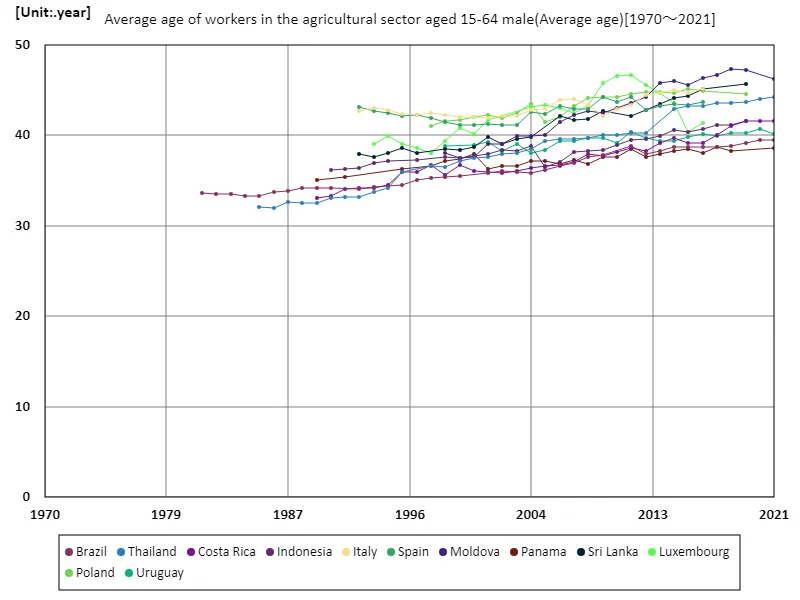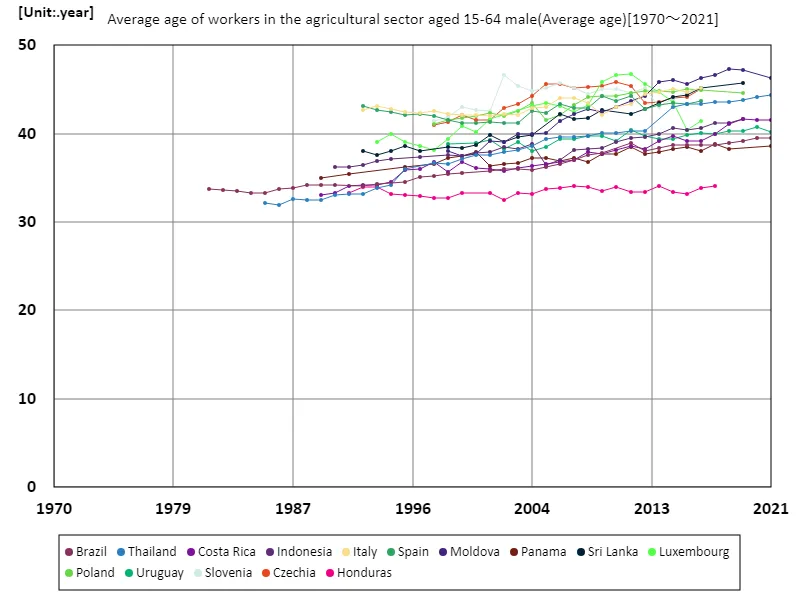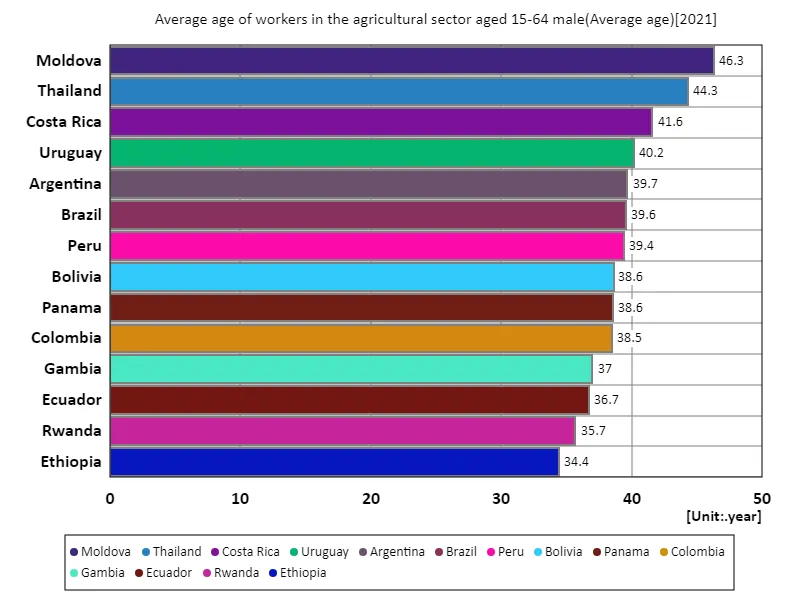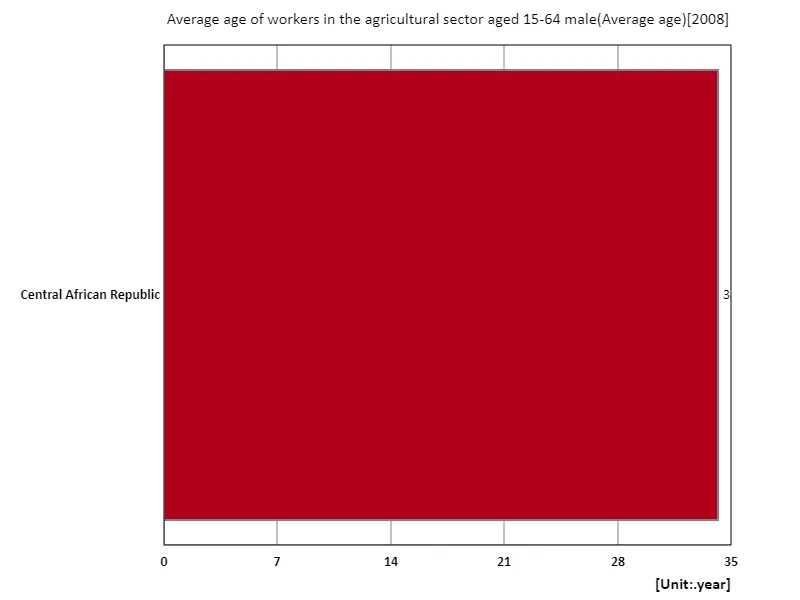Abstract
The average age of male workers aged 15-64 in Moldova’s agricultural sector stands at 46.3 years, indicating some important trends. First, ageing in the agricultural sector is a common phenomenon observed in many countries. Young people are turning away from agriculture and moving to cities, as well as low wages and harsh working conditions, are contributing to the ageing of agricultural workers. This trend is particularly pronounced in Moldova, where the agricultural sector’s workforce is aging, raising concerns about labor shortages and declining productivity. This ageing population can have an impact on the sustainability and efficiency of agriculture, and policies are needed to encourage the involvement of younger generations. Agricultural modernization and support policies are urgently needed, and labor markets need to be improved.
Agriculture sector, male workers aged 15-64, average age
Data from 1981 to 2021 shows a notable increase in the average age of male workers aged 15-64 in the agricultural sector. Moldova in particular recorded a record high of 47.3 years in 2018, and is currently at 46.3 years, or 97.8% of that figure. This ageing population is thought to be due to a decline in agricultural labor force participation among younger workers, migration to urban areas, and low wages and harsh working conditions in the agricultural sector. The ageing of the agricultural sector can have serious implications for workforce sustainability and productivity. Older workers are more physically challenged and less willing to learn skills and adopt innovations, which could make the entire industry less competitive. Furthermore, with young people increasingly turning away from agriculture, a large number of older workers will make it difficult for agriculture to continue to develop. To counter this trend, agriculture needs to be modernized, efficient technology introduced, and incentives provided to the younger generation. It is urgent to secure the next generation of labor by improving working conditions and making agriculture more attractive.


The maximum is 47.3year[2018] of Moldova, and the current value is about 97.8%
Agriculture sector, male workers aged 15-64, average age (worldwide)
Data from 1981 to 2021 shows a notable increase in the average age of male workers in the agricultural sector aged 15-64. In particular, Moldova recorded a record high of 47.3 years in 2018 and has maintained a high level since then. The current average age is 46.3 years old, which is 97.8% of that age, and the population is still aging. The main factors behind this aging population include young people moving away from agriculture and migrating to urban areas, as well as low wages and harsh working conditions in the agricultural sector. The aging workforce in the agricultural sector is resulting in physical constraints and delays in technological innovation, raising concerns about declining productivity and labor shortages. Furthermore, the involvement of young people is essential for the continued development of agriculture, and an aging population poses a challenge in this regard as well. Solutions include modernizing agriculture, promoting efficiency, and introducing policies that will attract the younger generation. There is an urgent need to develop sustainable agriculture by improving working conditions and promoting innovation in agricultural technology.


The maximum is 47.3year[2018] of Moldova, and the current value is about 97.8%
Agriculture sector, male workers aged 15-64, average age (world, latest year)
According to 2021 data, the average age of male workers aged 15-64 in the agricultural sector is 39.3 years, with Moldova recording the highest figure at 46.3 years. This trend indicates that the agricultural sector is ageing. The ageing of the agricultural sector is mainly due to young people leaving agriculture, migration to cities, and the difficult working conditions of agriculture. In countries with a high average age, such as Moldova, there are concerns about the sustainability and productivity of the workforce. Older workers have physical limitations that make it harder for them to adapt to technological changes, which can affect agricultural productivity. However, the overall trend, with a mean age of 39.3 years, reflects an ageing agricultural sector globally, but also suggests differences across countries. This is influenced by differences in each country’s agricultural policies, labor market conditions, and level of economic development. Future measures will require modernizing agriculture and making it more efficient, as well as providing incentives to attract younger generations into the sector. Policies and support that increase the attractiveness of agriculture will contribute to securing a sustainable labor force.


The maximum is 46.3year of Moldova, the average is 39.3year, and the total is 550year
Agriculture sector, male workers aged 15-64, average age (region, latest year)
According to 2008 data, the average age of male workers aged 15-64 in the global agricultural sector was 34.2 years, with the Central African Republic recording the highest age. The data reflects that the agricultural sector is experiencing an ageing process that varies across regions. The Central African Republic’s high median age of 34.2 years points to an ageing agricultural workforce, a phenomenon also seen in many developing countries. The main factors include a lack of youth participation in the agricultural sector, migration to urban areas and harsh working conditions. The outflow of young people and the rise of an older workforce could have serious implications for the sustainability and productivity of the agricultural sector. The consistency in overall mean age of 34.2 years suggests that ageing in the agricultural sector is a widespread trend, with small variations across regions. To address this issue, it is urgent to promote agricultural efficiency and technological innovation, as well as introduce policies that attract younger generations. We need strategies to increase the attractiveness of agriculture and achieve sustainable development.


The maximum is 34.2year of Central African Republic, the average is 34.2year, and the total is 34.2year



Comments